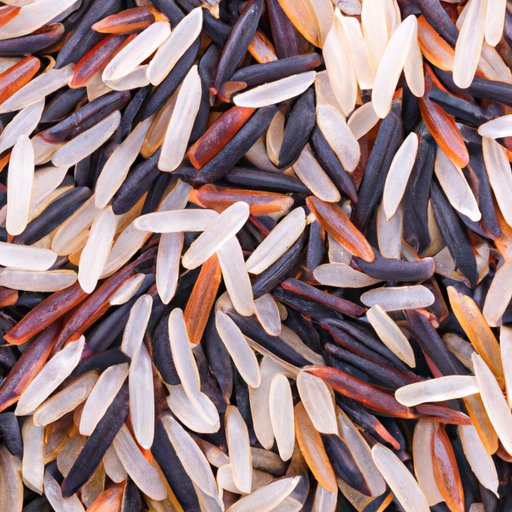I. Introduction
Rice is one of the most popular grains consumed worldwide, with an estimated 500 million metric tons produced annually. While rice is widely loved and eaten globally, choosing the healthiest type of rice can be challenging. This article aims to compare the nutritional values and health benefits of different types of rice to help readers make informed choices for a healthy diet.
II. Brown Rice vs. White Rice
Brown rice is an unrefined whole grain rice with the outer bran layer intact and the germ still present, while white rice is a refined grain with the bran layer and germ removed. While brown rice is higher in fiber, vitamins, minerals, and antioxidants, white rice is generally lower in these nutrients, aside from being enriched with added vitamins and minerals. Brown rice also has a lower glycemic index (GI) than white rice, making it a healthier option for managing blood sugar levels.
III. Health Benefits of Various Types of Rice
Aside from brown and white rice, there are multiple other varieties of rice, including basmati, jasmine, wild, and black rice. Basmati and jasmine rice are popular choices for their fragrant aroma, while wild and black rice are known for their nutty flavors and unique colors. Each rice variety has different nutritional benefits, with black rice being high in antioxidants, wild rice being high in protein and fiber, and basmati and jasmine rice being good sources of minerals such as magnesium and potassium.
While each type of rice has its distinct health advantages, brown rice consistently ranks as one of the healthiest types, followed by black rice and wild rice.
IV. Glycemic Index of Different Types of Rice
Glycemic index (GI) measures how quickly food raises blood sugar levels, with lower GI foods raising blood sugar levels more slowly than higher GI foods. Brown rice has a lower GI than white rice, and black rice has an even lower GI than brown rice. Wild rice also has a relatively low glycemic index due to its high protein and fiber content. Therefore, brown, black, and wild rice are healthier options for those who want to maintain stable blood sugar levels.
V. Rice in Different Cultures and Cuisines
Rice is a staple food in many cultures, especially in Asia, where it is consumed in large quantities. White rice is the most commonly consumed rice in Asian cuisines, but brown rice is becoming increasingly popular as a healthier alternative. In Latin America, rice is often served with beans, creating a protein-rich meal. In Indian cuisines, basmati rice is popular due to its fragrant aroma, while black rice is used in traditional Thai dishes. While some cultural dishes may use white rice, substituting brown, black, or wild rice can increase the nutritional value of the dish.
VI. Buying, Cooking, and Incorporating Rice into a Healthy Diet
When buying rice, consumers should consider the type of rice they prefer and its nutritional quality. Brown, black, and wild rice are healthier options than white rice. When cooking rice, adding flavorful broth or herbs can enhance its taste while cooking it with the right amount of water can make it chewy and delicious. Rice can be incorporated into a healthy diet by being used as a base for salads, as a side dish for vegetables, or in place of noodles to make stir-fries.
VII. Scientific Research on the Health Benefits of Rice
According to scientific research, incorporating rice into a healthy diet can have numerous benefits, such as aiding in digestion, regulating bowel movements, maintaining a healthy weight, and reducing the risk of chronic diseases such as diabetes, heart disease, and certain types of cancer. Brown and black rice, in particular, have been associated with lower risks of developing type 2 diabetes due to their low GI value.
VIII. Conclusion
Choosing the healthiest type of rice can seem overwhelming, but the benefits of incorporating it into your diet can be significant. While white rice can be enjoyed in moderation, brown, black, and wild rice are healthier options due to their higher fiber, nutrient, and antioxidant content. It is essential to remember that all rice varieties can be part of a healthy diet when consumed in moderation and paired with nutrient-rich foods.
Therefore, I recommend that you increase your intake of healthy rice choices and consider substituting brown, black, or wild rice for white rice whenever possible.
(Note: Is this article not meeting your expectations? Do you have knowledge or insights to share? Unlock new opportunities and expand your reach by joining our authors team. Click Registration to join us and share your expertise with our readers.)
